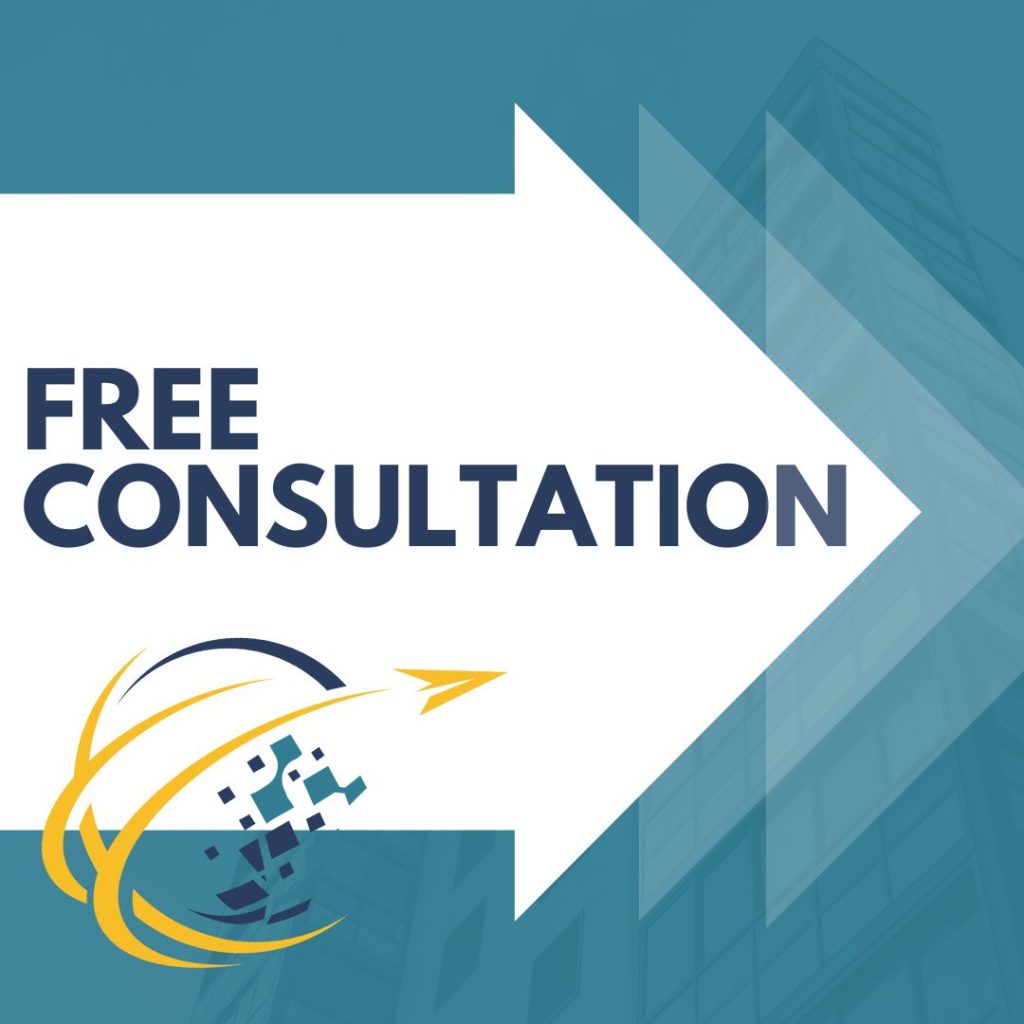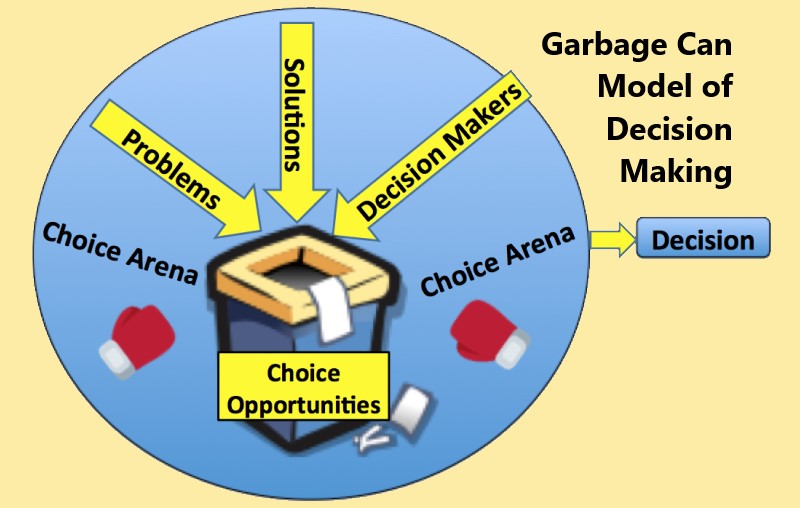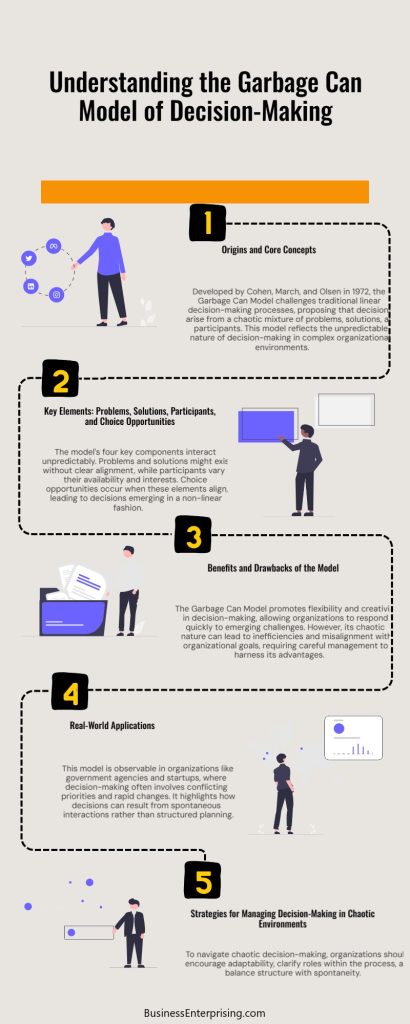 The Garbage Can Model of Decision-Making offers a unique view on how decisions happen in complex organizations. Developed in the 1970s, this model challenges the idea that decision-making is always orderly. Instead, it suggests that decisions often emerge from a random mix of problems, solutions, and participants. Unlike structured models, the Garbage Can Model embraces chaos, allowing for spontaneous combinations that may lead to unexpected choices. This approach is particularly relevant in dynamic environments where order is hard to maintain. Understanding the Garbage Can Model of Decision-Making can help you navigate complex situations, fostering adaptability and creative problem-solving.
The Garbage Can Model of Decision-Making offers a unique view on how decisions happen in complex organizations. Developed in the 1970s, this model challenges the idea that decision-making is always orderly. Instead, it suggests that decisions often emerge from a random mix of problems, solutions, and participants. Unlike structured models, the Garbage Can Model embraces chaos, allowing for spontaneous combinations that may lead to unexpected choices. This approach is particularly relevant in dynamic environments where order is hard to maintain. Understanding the Garbage Can Model of Decision-Making can help you navigate complex situations, fostering adaptability and creative problem-solving.
Introduction to the Garbage Can Model: Origins and Core Concepts
The Garbage Can Model of Decision-Making, developed by Michael Cohen, James March, and Johan Olsen in 1972, offers a unique view of organizational decision-making. Unlike traditional models that assume decisions follow a structured, linear process, this model highlights the chaotic and unpredictable nature of decision-making. In the Garbage Can Model, decisions are not simply about solving problems in an orderly way. Instead, they emerge from a random mix of problems, solutions, participants, and “choice opportunities.”
At the heart of the Garbage Can Model of Decision-Making is the idea that organizations are often chaotic environments where multiple issues and solutions exist at once. People bring problems, ideas, and preferences to decision-making processes, yet these elements don’t always align smoothly. Sometimes, participants present solutions before they clearly define problems or fully understand their roles. As a result, decisions occur when the “garbage” of various inputs aligns, rather than through intentional planning.
This model is especially relevant in organizations that face frequent change, unclear goals, or loosely structured decision-making. By accepting that decisions may be unplanned and spontaneous, the Garbage Can Model encourages you to embrace flexibility. It acknowledges that, in reality, decision-making is often messy, and outcomes can depend as much on timing and luck as on systematic analysis. This perspective provides valuable insights for navigating complex organizational environments where predictability is rare.
How the Garbage Can Model Differs from Traditional Decision-Making Models
The Garbage Can Model of Decision-Making differs significantly from traditional decision-making models, which typically assume a clear, step-by-step process. Traditional models suggest that decision-making follows a logical path: identifying a problem, generating solutions, evaluating options, and making a choice. In these structured models, decisions are deliberate, with each stage designed to lead smoothly to the next. This approach assumes a certain level of clarity, order, and predictability.
In contrast, the Garbage Can Model of Decision-Making accepts and even emphasizes disorder. It suggests that in many organizations, decisions are not always driven by a clear problem-solving process. Instead, choices emerge when various “streams” of problems, solutions, participants, and opportunities happen to collide. This model reflects the reality that decisions in complex environments can be unpredictable and even chaotic. Problems may appear without a solution, or solutions may exist before a specific problem arises. Participants may vary in interest and availability, adding another layer of randomness to the process.
This spontaneous mix makes the Garbage Can Model unique. Rather than following a linear approach, it views decision-making as a process that depends heavily on timing, chance, and the current mix of inputs. This model recognizes that in some organizational settings, especially those facing ambiguity or frequent change, decisions often emerge from coincidence rather than planned action. By highlighting these differences, the Garbage Can Model provides a valuable perspective for understanding decision-making in environments where structure is limited.
Key Elements of the Garbage Can Model: Problems, Solutions, Participants, and Choice Opportunities
The Garbage Can Model of Decision-Making includes four key elements: problems, solutions, participants, and choice opportunities. Each component plays a unique role, interacting unpredictably to influence the decision-making process. Unlike in traditional models, these elements do not follow a set order. Instead, they mix together in a random, sometimes chaotic, manner.
Problems in this model are issues or needs that arise within the organization. However, they may not always be clearly defined or prioritized. Problems float within the decision-making “garbage can” and are addressed only if they intersect with available solutions, participants, and choice opportunities. In some cases, problems exist for long periods without resolution, waiting for the right conditions to align.
Solutions are another essential element. They represent potential answers or actions that may or may not align with existing problems. In the Garbage Can Model, solutions often exist independently of problems and are ready for application when a fitting opportunity arises. Sometimes, participants propose solutions even before they clearly recognize a problem, adding to the model’s chaotic nature.
Participants refer to the people involved in decision-making. Each participant brings their own interests, expertise, and availability, which can vary widely. This variability adds unpredictability, as participants may enter or exit the process at any time. Finally, choice opportunities are moments when decisions can be made. These opportunities serve as the container where problems, solutions, and participants come together. When these elements align within a choice opportunity, a decision may emerge.
In the Garbage Can Model of Decision-Making, these components mix spontaneously rather than following a structured path. This unstructured approach acknowledges the messy, dynamic nature of decision-making in complex organizations, where timing and chance often play significant roles.
Benefits and Drawbacks of the Garbage Can Model in Organizational Decision-Making
The Garbage Can Model of Decision-Making offers certain benefits, particularly in complex and dynamic environments. One key advantage is flexibility. Since decisions are not bound by a rigid process, this model allows you to respond quickly to emerging problems or opportunities. Flexibility can lead to creative solutions, as people bring in ideas and options that may not align with a specific issue at first but later prove valuable. This spontaneous mix of elements can also encourage innovation, as participants experiment with different approaches when traditional methods may not apply.
However, the Garbage Can Model of Decision-Making also has its drawbacks. The lack of structure can create inefficiencies. Because problems, solutions, and participants enter the process at random, decisions may take longer to finalize. Sometimes, issues go unresolved because the right combination of elements does not align, causing delays and frustration. Additionally, with such an unpredictable approach, there is a risk of misalignment between the organization’s broader goals and the choices being made.
A lack of direction can further complicate decision-making under this model. Without a structured path, participants may lose focus or struggle to prioritize, leading to confusion. In some cases, organizations may spend resources on problems that aren’t central to their mission. Despite these challenges, you can use the Garbage Can Model effectively when managed carefully, especially in settings that value adaptability and creativity over consistency and order. By recognizing its benefits and limitations, you can decide when this model best suits your organization’s needs.
Real-World Applications of the Garbage Can Model
You can observe the Garbage Can Model of Decision-Making in various real-world organizations, particularly in large bureaucratic or fast-paced environments. One example is within government agencies, where complex issues, varying participant priorities, and multiple solutions often interact chaotically. In such settings, decisions may arise from a mix of political pressures, emerging problems, and available resources. For instance, policy changes can occur not because they were carefully planned, but because the right mix of participants and problems aligned at a particular moment. This process allows flexibility but can also result in delayed or fragmented outcomes.
Some technology startups provide another example. In these dynamic environments, teams often make decisions quickly and without structure, closely resembling the Garbage Can Model. Startups frequently deal with shifting priorities, unexpected challenges, and a need for immediate problem-solving. A solution or product feature might be developed before a specific problem is identified, only to later find a fitting application. While this model promotes innovation and allows for quick adaptation, it can also lead to resource strain when priorities shift too rapidly or when choices lack clear direction.
Universities also demonstrate the Garbage Can Model of Decision-Making, especially in committee-based decisions. With many competing interests, such as academic goals, funding constraints, and faculty perspectives, decisions often emerge from a mixture of issues, solutions, and available participants. In some cases, decision-makers approve a policy not through a direct, intentional process but because it aligns with the interests at that time. Lessons from these examples highlight that while the Garbage Can Model offers flexibility, it may also require careful management to avoid inefficiencies and ensure alignment with organizational goals.
Practical Strategies for Managing Decision-Making in Chaotic Environments
In chaotic decision-making environments, fostering adaptability is essential. The Garbage Can Model of Decision-Making highlights the unpredictable nature of choices, making flexibility a valuable asset. Encourage your team to embrace change and approach challenges with an open mind. When team members are adaptable, they can respond effectively to sudden shifts and find innovative solutions in unexpected situations.
Clarifying roles is another key strategy. In chaotic environments, participants may struggle with overlapping responsibilities or unclear expectations. By defining each person’s role in the decision-making process, you can reduce confusion and ensure that participants contribute efficiently. Even in a flexible model, clear roles create a foundation that allows for smoother interactions and more purposeful contributions.
Balancing structure with spontaneity is also important. While the Garbage Can Model thrives on a degree of randomness, too much disorder can hinder progress. Introduce a framework that guides the decision-making process without limiting creativity. For example, establish regular check-ins to review goals and discuss ongoing issues. These moments of structure can help organize ideas and keep the team aligned while still allowing for spontaneous, innovative thinking. Together, these strategies can help you navigate chaotic environments, turning disorder into productive opportunities for growth and problem-solving.
Conclusion
The Garbage Can Model of Decision-Making provides a valuable perspective for navigating complex, chaotic environments. By embracing flexibility and spontaneity, this model allows you to adapt quickly when traditional processes might fall short. Though challenging, managing decision-making in this way encourages creativity and resilience, especially when clear roles and a balance between structure and freedom are in place. Understanding and applying the Garbage Can Model of Decision-Making can help your organization thrive amid unpredictability, turning uncertainty into a pathway for innovation and growth.


